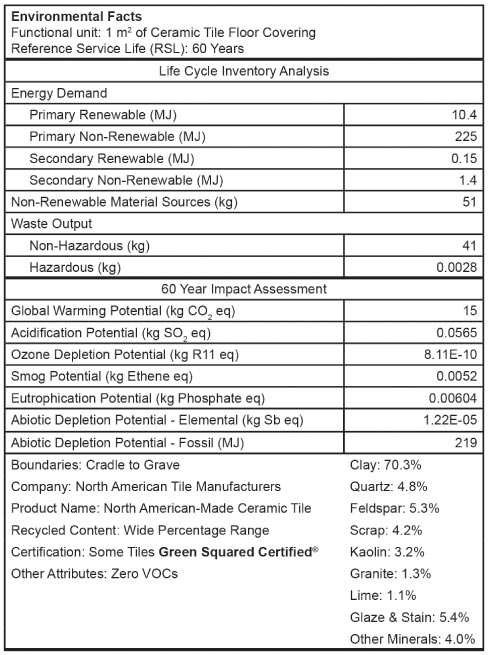UL-Certified EPD for North American-Made Ceramic Tile Paves the Way for Compliance in Green Construction
 The Environmental Product Declaration (EPD) for ceramic tile made in North America, certified by sustainability leader UL Environment, is now available for use by architects, designers and specifiers seeking to satisfy green building project requirements, such as those set forth by LEED and Green Globes.
The Environmental Product Declaration (EPD) for ceramic tile made in North America, certified by sustainability leader UL Environment, is now available for use by architects, designers and specifiers seeking to satisfy green building project requirements, such as those set forth by LEED and Green Globes.
 The 23-page report, downloadable at www.TCNAtile.com, is a comprehensive disclosure of the environmental impacts of North American-made ceramic tile. When using this certified EPD alongside other flooring products’ EPDs one thing is clear: Ceramic tile has the lowest 60-year environmental impact per square foot (and per square meter) across all major impact categories: global warming, abiotic resource depletion, acidification, smog formation, eutrophication, and ozone depletion.
The 23-page report, downloadable at www.TCNAtile.com, is a comprehensive disclosure of the environmental impacts of North American-made ceramic tile. When using this certified EPD alongside other flooring products’ EPDs one thing is clear: Ceramic tile has the lowest 60-year environmental impact per square foot (and per square meter) across all major impact categories: global warming, abiotic resource depletion, acidification, smog formation, eutrophication, and ozone depletion.
“These are the most commonly referenced environmental impact categories relating to how the manufacture and use of a product will affect the well-being of humans and our environment,” says Bill Griese, the Green Initiative Manager for Tile Council of North America (TCNA). “With the EPD in hand, building designers and owners can now make better informed product choices with respect to sustainability.”
Not only does the certified EPD for North American-made ceramic tile report tile’s low environmental impact, it also offers the environmental transparency and reporting necessary for building design professionals to satisfy requirements for countless green building points and green building criteria.
As all major North American manufacturers provided data aggregated to produce the EPD – specifically Arto, Crossville, Dal-Tile Corporation, Florida Tile, Florim USA, Interceramic, Ironrock, Porcelanite Lamosa, Quarry Tile Company, StonePeak Ceramics, and Vitromex de Norteamérica – the EPD represents well over 95% of the tile produced in North America. Hence, virtually all ceramic tile made in North America can help building design professionals meet sustainability requirements for transparency. The EPD’s use can contribute to earning up to 2 points under LEED v4 provisions, which require the use of at least 20 products with EPDs and 50% of products with improved life cycle performance. Additionally, use of North American-made tile can contribute toward earning up to 30 points under Green Globes provisions for core, shell, and interior fit-outs. And its use can facilitate earning the 3 available points in CHPS (Collaborative for High Performance Schools) for using at least 10 products with EPDs.
“Representing the broad spectrum of North American tile, this certified EPD is a powerful and useful tool for specifiers concerned with sustainable construction and who are looking to include tile in their projects,” according to Eric Astrachan, Executive Director of TCNA.
Under 2014 ASHRAE Standard 189.1, the use of North American-made ceramic tile now helps fulfill requirements to use products with EPDs; the same is true for the 2015 International Green Construction Code (IgCC), which doubles a tile’s contribution toward compliance if it is also Green Squared Certified®, meaning it conforms to the Green Squared® standard (ANSI A138.1) for sustainability. Similarly, the 2014 GSA Facilities Standards for Public Buildings, P-100, requires Green Squared certification and the availability of an EPD under the sustainability provisions of its tiling section.
The California Green Building Code for non-residential construction and the 2012 NAHB National Green Building Standard include provisions for the use of materials with lower life cycle environmental impacts than alternative options based on a 60-year assessment. Since the EPD for North American-made tile provides a 60-year assessment showing lower environmental impacts than those found in EPDs of alternative flooring options, North American-made ceramic tile can help satisfy those requirements.
The EPD specific to North American-made ceramic tile is derived from in-depth analysis of data related to tile manufacturing and use--from the raw material extraction process to disposal of tile at the end of its life--with emphasis on the priority considerations of the green building community, including energy and resource consumption and emissions to air, land, and water. The environmental impacts that are measured and the methodology for measuring them are dictated by the North American Product Category Rule (PCR) for flooring EPDs. By following this standard, the ceramic tile EPD reports the environmental facts of ceramic tile in a fashion similar to other flooring EPDs, much as nutrition labeling for food is standardized in order to simplify its use.
Third party certification of the EPD by UL Environment ensures that users of the EPD are relying on information verified as accurate, versus unsubstantiated marketing claims and other attempts at “greenwashing.”
“Green construction continues to evolve, with a trend toward more stringent requirements for evaluating and reporting environmental impacts. Manufacturers can no longer focus on single attributes, like recycled content or VOCs, or generalize when it comes to sustainability,” says Griese. “The North American ceramic tile EPD provides the environmental reporting rigor and specificity that building designers and owners are increasingly demanding.” He adds, “product selection involves balancing a wide array of information. Designers and specifiers need to feel comfortable that environmental pros and cons are weighed throughout the product selection process and that their decisions are based on reliable, life cycle-based sustainability information.”
Production of the North American Ceramic Tile EPD was a collaborative effort of the Tile Council of North America (TCNA) and its participating members, with data analysis and modeling by PE International and third party independent certification by UL Environment.
For more information contact Bill Griese, TCNA Green Initiative Manager, at 864-646-8453, or email bgriese@tcnatile.com.